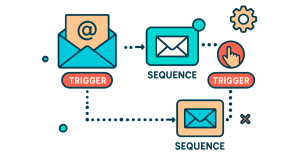Marketing automation technology – software specifically – should make our working lives easier and help us automate tasks that otherwise would have to be thought-to-do and done manually. Doesn’t that sound beneficial? Of course it does. Problem is, it takes time – and know-how.
In the case of marketing automation software users, most are only using the manual portions of their software. According to Litmus, fewer than 5% of all marketing emails are automated. Marketing automation software users often sending emails (albeit often beautiful ones) manually…how dare they! Yes they’re marketing, but no they’re not automating.
We often say that the digital marketing strategy should be the hard part, then it’s the job of our software to help create – and yes even automate – and that should be the easy part. Designing hard, building easy.
But before we ask you to do any of that, shouldn’t we all be on the same webpage regarding terminology? That’s the purpose of this blog, so let’s start there.
Don’t Love Your Email Results?
Download the anatomy of a marketing email template
Let’s start with the definition of what is marketing automation – and its sidekicks.
Automation – A set of triggers and filters that is attached to one or more groups—sometimes defined as “action groups”. An automation includes at least one trigger and can also include filters and actions. You’ll commonly hear automation in reference to email, as in you are automating an email based on a certain set of triggers or actions.
Actions – Events that happen based on the trigger or the definition of the group. An example of an action is a trigger immediately sending an email—although you may also think of the “action” as the recipient taking an action with an email (click, open, etc.) and your marketing automation platform’s reaction (what you automated next based on the action that contact took).
Dynamic Groups – A dynamic group is a group that is always changing and growing automatically. It can be made up of contacts that match certain features (location, industry, email domain, etc.) or that match certain actions (clicks, opens, landing page visits, etc.).
Static Groups – Static groups are built once and must be manually maintained. Unless you physically add someone to that group, the group count will reflect what you originally built.
Decisions – Decisions are actions you add to your workflow canvas to tell your marketing automation software what to do next. Want to send Email #2 just to people who clicked on Email #1? That’s a Click Decision. Want to send Email #2 to people who don’t belong to a certain group or who don’t live in a specific region? That’s a Custom Decision. Decisions help your platform understand who should get what message based on the contact’s profile or actions.
Trigger – An event that results in a reaction within your marketing automation software—this could be a trigger from your CRM system (a Lead is added to a Marketing List, for example) or a trigger from within a workflow (a person converts on a landing page form and thus should or should not receive the next email in your series).
Variables – Variables like $$firstname or $$company allow you to customize the email content to each recipient. The variable connects to a corresponding field on the contact’s profile. Some marketing automation platforms allow you to create your own variables, which you can also connect to…
Content Blocks – Content blocks allow you to create a consistent block of content that can be dragged in as-is into the content of an email. You can set restrictions on who can use what block of pre-set content or use variables to customize which contacts see which blocks.
Filter – An optional part of an automation that is used to narrow the scope of triggers. Think of filters as a way to add these people but not those people to a certain group. Filters help you segment your list and create more targeted email campaigns.
Ready to go a little deeper?…you’ve got this, KEEP GOING!
Condition – A modifier that determines how a trigger fires. Conditions can inform triggers, like “exact” matches, “more or less” matches, or “before or after” matches.
Custom Fields – Each contact record in your marketing automation software is made up of fields, some of which are out of the box (like email, first name, last name, company, etc.), and some of which are custom fields. Custom fields allow you to create places to store data that is necessary for your targeting and segmenting—and what you store here will be dependent on what you’re trying to achieve with your marketing. Be sure your custom fields map between your marketing automation platform and CRM system or ecommerce engine for the best targeting options!
Campaigns – If you’re a CRM user, you’re probably thinking about Campaigns in the context of a single activity or event (like a trade show or a direct mail campaign). In some marketing automation software (like the emfluence Marketing Platform), you can add landing pages, social media sends, emails, groups, and surveys into a single campaign to view holistic reporting.
Transactional – Think of a transactional email as the third type of send (alongside manual and automated emails). Transactional email is sent as a part of a “transaction”—it’s like the email equivalent of a receipt. Learn more about what you can and can’t do in these emails here.
Skip Logic – In reference to surveys, skip logic allows you to decide what actions or answers could allow a survey taker to “skip” pages or questions within a survey.
Alternate Endings – Also in reference to surveys, alternate endings in the survey feature of marketing automation software allow you to end a survey differently depending on the answers the survey taker provides.
Gated Content – In marketing automation terms, this refers to the act of allowing contacts to download content based on them filling out a form created in the marketing automation platform. You would most likely use a landing page, a form, and an automated email to deliver the content—all of which would be built and managed in your marketing automation platform.
Query Builder – A query builder often exists in marketing automation software and CRM software. This tool allows you to search your contact database for contacts that match certain features or characteristics. You could search based on data within fields, group membership, dates added or removed, and more to create a new group for marketing.
Modals – Modals are the pop ups you often see on website pages. They are common for gathering email subscriptions and for informing website visitors of sales, newsworthy information, and more. Modals can connect to landing pages or forms to help you gather and build your opt-in email list.
And finally…
Repeatable Action Group – an action group that can be scheduled as often as needed and automatically (repeatedly) activates when conditions are met. The action group will attempt to apply each action to the lead as many times as the action group is applied (such as with a repeatable email). With repeatable action groups, it is important to know why you are making it repeatable. As an example, when triggering automation, the action group will continue to apply as many times as the automation was triggered (such as with form fill confirmations).
Branches – a collection of actions created for use only within a visual workflow. As the name implies, this collection of actions “branch out” from the action group and are dependent upon additional criteria in order to function.
Don’t see what you’re looking for on the list? Ping us in the comments and we’ll add it.
Next step, thinking strategy! Need further help? Give us a shout – we’re ready to listen.
Ready to get started?


